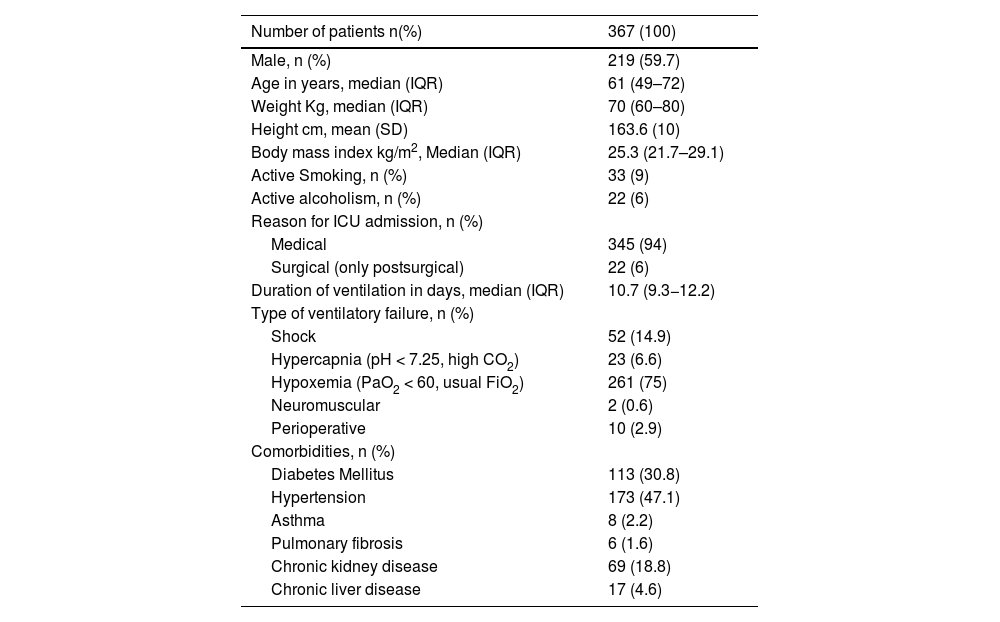To assess the predictive capacity of the Rapid Shallow Breathing Index (RSBI) for success in spontaneous breathing trials (SBT) and extubation in critically ill patients. We evaluated the association between RSBI, duration of mechanical ventilation, and ventilator-free time at 28 days.
DesignProspective multicenter observational study. Secondary analysis of the COBRE-US study.
SettingIntensive care unit (ICU).
Patients or participants367 patients in the ICU receiving invasive mechanical ventilation.
InterventionsAssessment of RSBI at the end of SBT.
Main variables of interestRSBI, SBT, duration of mechanical ventilation, and ventilator-free time at 28 days were evaluated.
Results367 patients in the ICU under invasive mechanical ventilation were evaluated, of whom 59.7% were male with a median age of 61 years (IQR: 49–72). A total of 456 SBT were conducted with a success rate of 76.5%. RSBI had a ROC-curve of 0.53 for SBT success and a ROC-curve of 0.48 for extubation. The Spearman correlation coefficient between RSBI and duration of ventilation was 0.117 (p = 0.026), while for ventilator-free time at 28 days, it was −0.116 (p = 0.028).
ConclusionsRSBI was not associated with success in SBT or extubation, regardless of the cutoff point used. Correlation analyses showed weak associations between RSBI and both the duration of ventilation and ventilator-free time at 28 days.
Evaluar la capacidad predictiva del Índice de Respiración Superficial Rápida (IRSR) para el éxito en la prueba de respiración espontánea (PRE) y extubación en pacientes críticamente enfermos. Se evaluó la asociación entre IRSR, la duración de la ventilación mecánica y el tiempo libre de ventilador a los 28 días.
DiseñoEstudio observacional prospectivo multicéntrico. Análisis secundario del estudio COBRE-US.
ÁmbitoUnidad de cuidados intensivo (UCI).
Pacientes o participantesPacientes en la UCI recibiendo ventilación mecánica invasiva.
IntervencionesEvaluación del IRSR al finalizar la PRE.
Variables de interés principalesSe evaluaron IRSR, PRE, duración de la ventilación mecánica y tiempo libre de ventilador a los 28 días.
ResultadosSe evaluaron 367 pacientes en la UCI bajo ventilación mecánica invasiva, de estos el 59.7% eran de sexo masculino con una mediana de edad de 61 años (RIC: 49–72). Se realizaron 456 PRE con tasa de éxito del 76.5%. El IRSR presenta una curva ROC de 0,53 para éxito del PRE y una curva ROC de 0.48 para extubación. El coeficiente de correlación de Spearman entre la IRSR y la duración de la ventilación fue de 0.117 (p = 0,026), mientras que para el tiempo libre de ventilación a los 28 días fue de −0.116 (p = 0.028).
ConclusionesEl IRSR no se asoció con la PRE ni en la extubación, independiente del punto de corte utilizado. Los análisis de correlación mostraron asociaciones débiles entre IRSR y tanto la duración de la ventilación como el tiempo libre de ventilador a los 28 días.
Article
Go to the members area of the website of the SEMICYUC (www.semicyuc.org )and click the link to the magazine.









